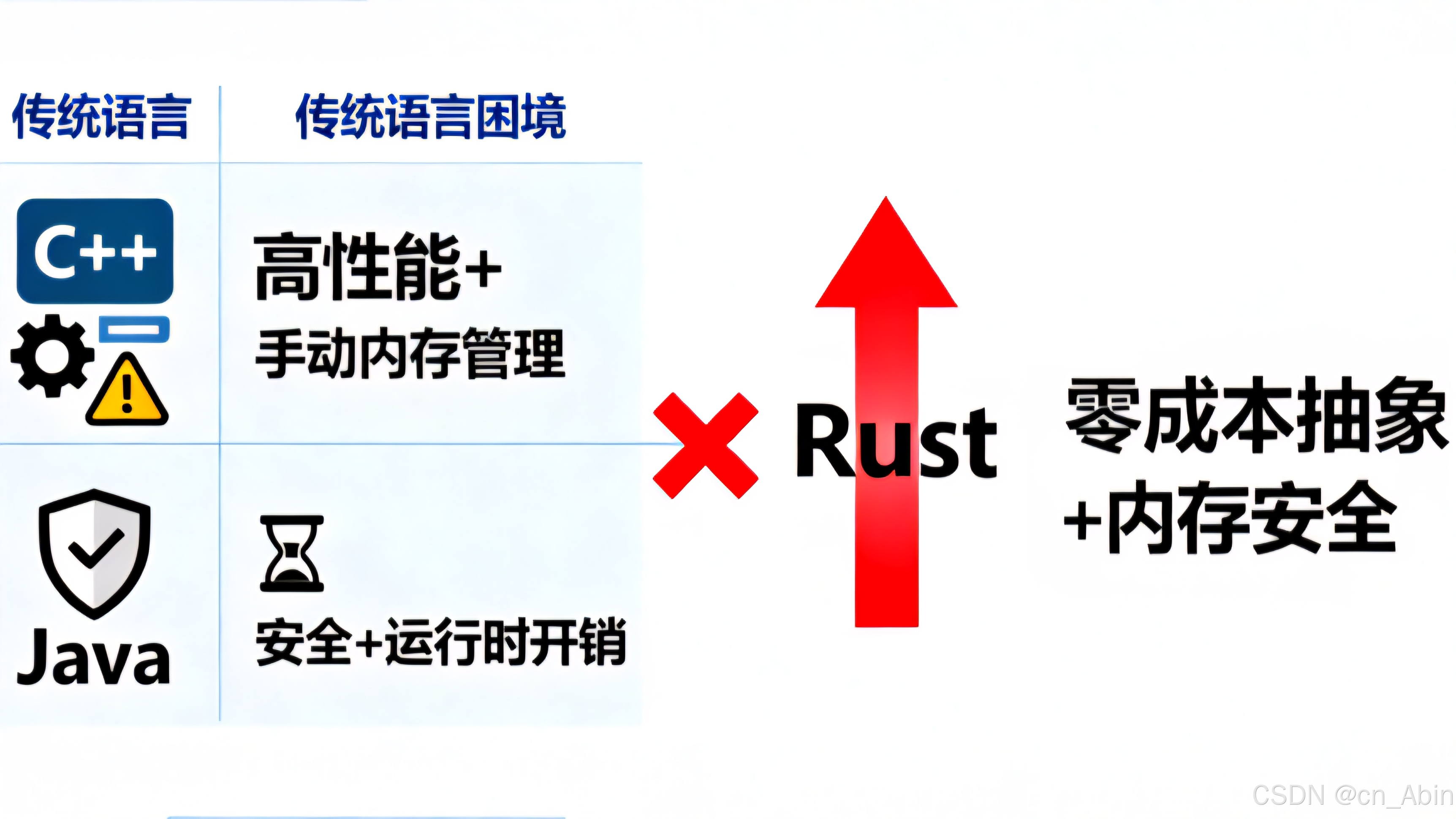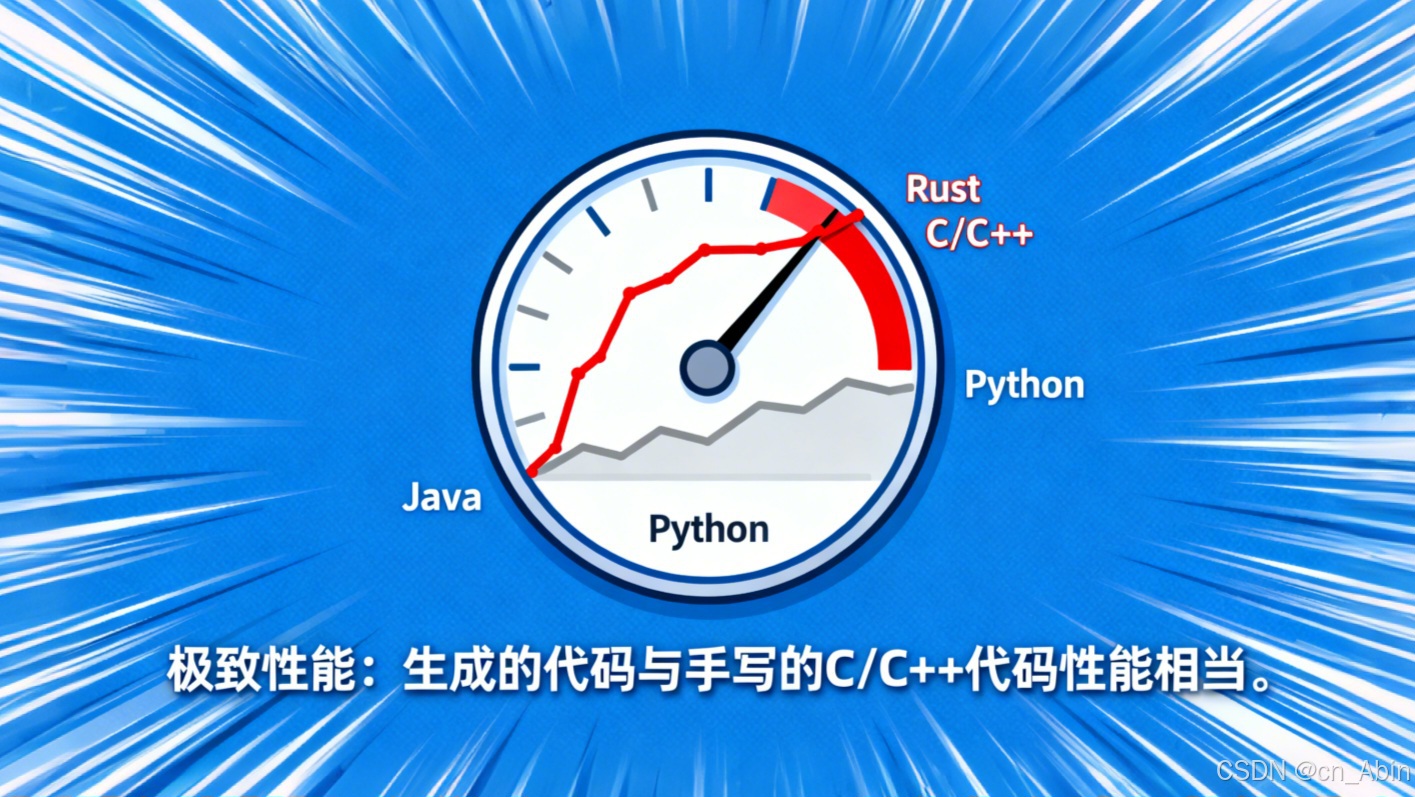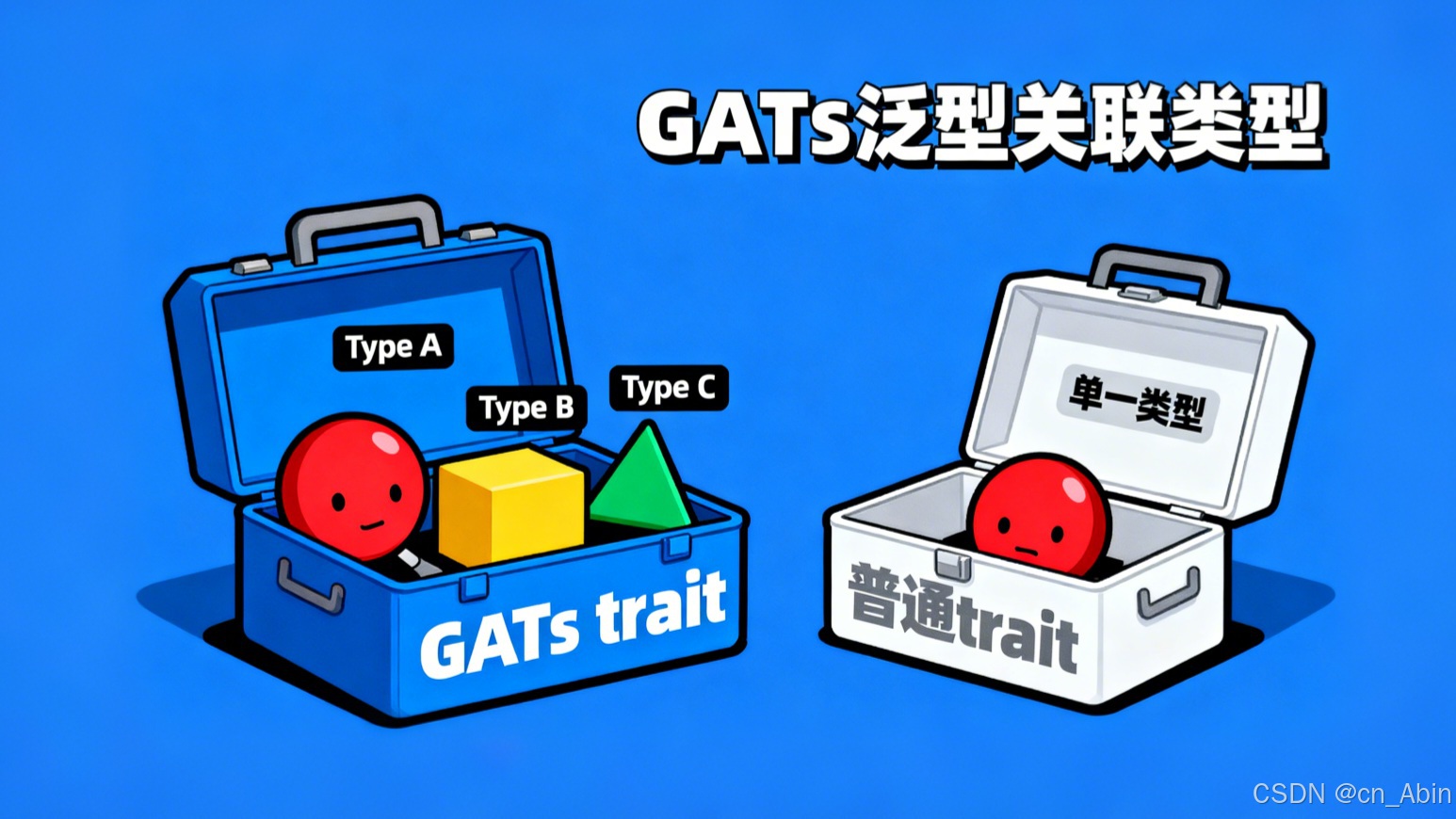Rust 中的零成本抽象:如何编写既安全又高效的代码
Rust 中的零成本抽象:如何编写既安全又高效的代码
一、引言:重新思考性能与安全的权衡
1.1 传统语言的困局
在传统的编程语言设计中,开发人员往往面临一个艰难的选择:是选择像 C++ 这样的高性能语言,但需要手动管理内存并承担安全风险?还是选择像 Java 或 Python 这样的安全语言,但需要接受运行时开销和性能损失?
这种二元对立的局面持续了数十年,直到 Rust 的出现彻底改变了这一格局。
1.2 Rust 的突破性解决方案
Rust 通过其创新的所有权系统和零成本抽象哲学,证明了安全性和性能并非不可兼得。让我们从一个简单的例子开始,感受 Rust 的魅力:
// 传统语言中的典型问题:悬垂指针
fn create_dangling_pointer() -> &'static Vec<i32> {
let data = vec![1, 2, 3, 4, 5];
&data // 错误!data 将在函数结束时被销毁
}
// Rust 中的安全版本
fn safe_version() -> Vec<i32> {
vec![1, 2, 3, 4, 5] // 所有权被转移给调用者
}
// 或者使用智能指针
use std::rc::Rc;
fn shared_ownership() -> Rc<Vec<i32>> {
Rc::new(vec![1, 2, 3, 4, 5])
}
1.3 零成本抽象的核心价值
Rust 的核心创新在于它将内存安全和并发安全检查从运行时移到了编译时。这意味着:
-
编译时保证:大多数错误在编译阶段就被捕获

-
零运行时开销:不需要垃圾收集器或运行时检查

-
极致性能:生成的代码与手写的 C/C++ 代码性能相当

二、什么是零成本抽象?
2.1 零成本抽象的定义
零成本抽象是 Rust 的核心设计哲学之一,最早由 C++ 社区提出,但在 Rust 中得到了更彻底和一致的贯彻。
2.2 两大基本原则
零成本抽象包含两个基本原则:
- 你不为你没有使用的功能付出代价
- 你手动编写的代码不会比抽象生成的代码更高效

2.3 实际代码示例
让我们通过一个具体的例子来理解这个概念:
// 高级抽象:使用迭代器和闭包
fn process_data_high_level(data: &[i32]) -> Vec<i32> {
data.iter()
.filter(|&x| x % 2 == 0) // 过滤偶数
.map(|x| x * 2) // 每个元素乘以2
.filter(|&x| x > 10) // 再次过滤
.collect() // 收集结果
}
// 等效的手动实现
fn process_data_low_level(data: &[i32]) -> Vec<i32> {
let mut result = Vec::new();
for &item in data {
if item % 2 == 0 {
let doubled = item * 2;
if doubled > 10 {
result.push(doubled);
}
}
}
result
}
// 测试两种实现的等价性
#[cfg(test)]
mod tests {
use super::*;
#[test]
fn test_equivalence() {
let data = vec![1, 2, 3, 4, 5, 6, 7, 8, 9, 10];
let high_level_result = process_data_high_level(&data);
let low_level_result = process_data_low_level(&data);
assert_eq!(high_level_result, low_level_result);
}
}
令人惊讶的是,经过编译器优化后,高级抽象版本通常与手动编写的低级版本具有相同的性能,甚至有时更优!
三、Rust 的所有权系统:编译时的内存安全卫士
3.1 所有权三原则详解
所有权系统是 Rust 最独特的特性,它通过编译时检查来保证内存安全,完全消除了运行时垃圾收集的开销。
// 1. 每个值都有一个所有者
fn ownership_demo() {
let s1 = String::from("hello"); // s1 是字符串的所有者
let s2 = s1; // 所有权从 s1 移动到 s2
// println!("{}", s1); // 错误!s1 不再拥有数据
}
// 2. 同一时间只能有一个可变引用
fn mutable_reference_demo() {
let mut data = vec![1, 2, 3];
let ref1 = &mut data; // 第一个可变引用
// let ref2 = &mut data; // 错误!不能同时有两个可变引用
process_vector(ref1);
}
// 3. 可以有多个不可变引用,但不能与可变引用共存
fn reference_demo() {
let mut data = vec![1, 2, 3];
let ref1 = &data; // 不可变引用
let ref2 = &data; // 另一个不可变引用,允许
// let ref3 = &mut data; // 错误!不能在有不可变引用的同时创建可变引用
println!("{}, {}", ref1, ref2);
}
3.2 生命周期注解
生命周期是 Rust 确保引用始终有效的关键机制。
// 没有生命周期注解的版本(编译错误)
// fn longest(x: &str, y: &str) -> &str {
// if x.len() > y.len() { x } else { y }
// }
// 正确的生命周期注解版本
fn longest<'a>(x: &'a str, y: &'a str) -> &'a str {
if x.len() > y.len() { x } else { y }
}
// 结构体中的生命周期
struct ImportantExcerpt<'a> {
part: &'a str,
}
impl<'a> ImportantExcerpt<'a> {
fn level(&self) -> i32 {
3
}
fn announce_and_return_part(&self, announcement: &str) -> &str {
println!("Attention please: {}", announcement);
self.part
}
}
fn lifetime_demo() {
let novel = String::from("Call me Ishmael. Some years ago...");
let first_sentence = novel.split('.').next().expect("Could not find a '.'");
let i = ImportantExcerpt {
part: first_sentence,
};
println!("First sentence: {}", i.part);
}
3.3 借用检查器的工作原理
借用检查器在编译时分析代码,确保所有引用都遵守所有权规则:
- 检查引用的生命周期不超过其引用的数据
- 确保不存在数据竞争
- 验证移动语义的正确性
四、迭代器:比手写循环更强大的抽象
4.1 基础迭代器操作
Rust 的迭代器不仅仅是语法糖,它们是零成本抽象的典范。
fn iterator_demo() {
let numbers = vec![1, 2, 3, 4, 5, 6, 7, 8, 9, 10];
// 链式操作
let result: Vec<i32> = numbers.iter()
.filter(|&&x| x % 2 == 0) // 过滤偶数
.map(|&x| x * x) // 平方
.take(3) // 取前3个
.collect(); // 收集结果
println!("{:?}", result); // [4, 16, 36]
}
4.2 自定义迭代器实现
我们可以为自定义类型实现 Iterator trait。
struct Fibonacci {
curr: u64,
next: u64,
}
impl Fibonacci {
fn new() -> Self {
Fibonacci { curr: 0, next: 1 }
}
}
impl Iterator for Fibonacci {
type Item = u64;
fn next(&mut self) -> Option<Self::Item> {
let new_next = self.curr.checked_add(self.next)?;
let result = self.curr;
self.curr = self.next;
self.next = new_next;
Some(result)
}
}
fn fibonacci_demo() {
let fib = Fibonacci::new();
// 使用迭代器适配器
let first_10_even_fibs: Vec<u64> = fib
.filter(|x| x % 2 == 0)
.take(10)
.collect();
println!("First 10 even Fibonacci numbers: {:?}", first_10_even_fibs);
// 无限序列的惰性求值
let large_fib = Fibonacci::new()
.skip(50) // 跳过前50个
.next()
.unwrap();
println!("51st Fibonacci number: {}", large_fib);
}
4.3 迭代器性能优化
编译器能够对迭代器链进行深度优化。
// 编译器能够优化的迭代器表达式
fn optimized_iterator_chain(data: &[i32]) -> i32 {
data.iter()
.map(|&x| x * 2)
.filter(|&x| x > 10)
.fold(0, |acc, x| acc + x)
}
// 等效的手动优化版本
fn manual_optimized_version(data: &[i32]) -> i32 {
let mut sum = 0;
for &x in data {
let doubled = x * 2;
if doubled > 10 {
sum += doubled;
}
}
sum
}
#[cfg(test)]
mod performance_tests {
use super::*;
use std::time::Instant;
#[test]
fn compare_performance() {
let data: Vec<i32> = (1..1000000).collect();
let start = Instant::now();
let result1 = optimized_iterator_chain(&data);
let duration1 = start.elapsed();
let start = Instant::now();
let result2 = manual_optimized_version(&data);
let duration2 = start.elapsed();
assert_eq!(result1, result2);
println!("Iterator version: {:?}", duration1);
println!("Manual version: {:?}", duration2);
// 通常两者性能相当,有时迭代器版本更快
}
}
五、智能指针:零成本的资源管理
5.1 Box:堆分配和动态分发
Box 是最简单的智能指针,用于在堆上分配数据。
// 使用 Box 进行堆分配
fn box_demo() {
let boxed_value = Box::new(42); // 在堆上分配一个整数
let boxed_vec = Box::new(vec![1, 2, 3]); // 在堆上分配一个向量
// 动态分发示例
trait Animal {
fn speak(&self);
}
struct Dog;
struct Cat;
impl Animal for Dog {
fn speak(&self) {
println!("Woof!");
}
}
impl Animal for Cat {
fn speak(&self) {
println!("Meow!");
}
}
let animals: Vec<Box<dyn Animal>> = vec![
Box::new(Dog),
Box::new(Cat),
];
for animal in animals {
animal.speak();
}
}
5.2 Rc 和 Arc:共享所有权
Rc 和 Arc 提供了引用计数式的共享所有权。
use std::rc::Rc;
use std::sync::Arc;
use std::thread;
// Rc:单线程引用计数
fn rc_demo() {
let shared_data = Rc::new(vec![1, 2, 3, 4, 5]);
let clone1 = Rc::clone(&shared_data);
let clone2 = Rc::clone(&shared_data);
println!("Reference count: {}", Rc::strong_count(&shared_data));
// 所有克隆共享相同的数据,没有拷贝发生
process_data(clone1);
process_data(clone2);
}
// Arc:原子引用计数,线程安全
fn arc_demo() {
let shared_data = Arc::new(vec![1, 2, 3, 4, 5]);
let mut handles = vec![];
for i in 0..3 {
let data = Arc::clone(&shared_data);
let handle = thread::spawn(move || {
println!("Thread {}: {:?}", i, data);
});
handles.push(handle);
}
for handle in handles {
handle.join().unwrap();
}
}
fn process_data(_data: Rc<Vec<i32>>) {
// 处理数据
}
5.3 Cell 和 RefCell:内部可变性
Cell 和 RefCell 提供了内部可变性模式。
use std::cell::{Cell, RefCell};
fn interior_mutability_demo() {
// Cell:适用于 Copy 类型
let cell = Cell::new(42);
cell.set(100);
println!("Cell value: {}", cell.get());
// RefCell:运行时借用检查
let ref_cell = RefCell::new(vec![1, 2, 3]);
{
let mut borrow = ref_cell.borrow_mut();
borrow.push(4);
} // 借用在这里结束
{
let borrow = ref_cell.borrow();
println!("RefCell contents: {:?}", borrow);
}
}
// 实际应用:实现一个简单的缓存
struct Cache<T>
where
T: Fn(i32) -> i32,
{
calculation: T,
value: RefCell<Option<i32>>,
}
impl<T> Cache<T>
where
T: Fn(i32) -> i32,
{
fn new(calculation: T) -> Self {
Cache {
calculation,
value: RefCell::new(None),
}
}
fn value(&self, arg: i32) -> i32 {
let mut cached_value = self.value.borrow_mut();
match *cached_value {
Some(v) => v,
None => {
let v = (self.calculation)(arg);
*cached_value = Some(v);
v
}
}
}
}
六、泛型和 Trait:编译时多态的威力
6.1 基础泛型使用
泛型允许我们编写可重用的代码,同时保持类型安全。
// 泛型函数
fn largest<T: PartialOrd>(list: &[T]) -> &T {
let mut largest = &list[0];
for item in list {
if item > largest {
largest = item;
}
}
largest
}
// 泛型结构体
struct Point<T> {
x: T,
y: T,
}
impl<T> Point<T> {
fn new(x: T, y: T) -> Self {
Point { x, y }
}
}
// 为特定类型实现方法
impl Point<f64> {
fn distance_from_origin(&self) -> f64 {
(self.x.powi(2) + self.y.powi(2)).sqrt()
}
}
6.2 Trait 系统和关联类型
Trait 定义了类型必须实现的功能集合。
// 定义 trait
trait Drawable {
fn draw(&self);
}
trait Geometry {
type Point;
type Vector;
fn translate(&mut self, vector: Self::Vector);
fn rotate(&mut self, angle: f64, center: Self::Point);
}
// 实现 trait
struct Circle {
x: f64,
y: f64,
radius: f64,
}
impl Drawable for Circle {
fn draw(&self) {
println!("Drawing circle at ({}, {}) with radius {}",
self.x, self.y, self.radius);
}
}
impl Geometry for Circle {
type Point = (f64, f64);
type Vector = (f64, f64);
fn translate(&mut self, vector: Self::Vector) {
self.x += vector.0;
self.y += vector.1;
}
fn rotate(&mut self, angle: f64, center: Self::Point) {
// 实现旋转逻辑
let (cx, cy) = center;
let dx = self.x - cx;
let dy = self.y - cy;
let cos_angle = angle.cos();
let sin_angle = angle.sin();
self.x = cx + dx * cos_angle - dy * sin_angle;
self.y = cy + dx * sin_angle + dy * cos_angle;
}
}
6.3 高级 Trait 特性
Rust 的 Trait 系统支持继承、默认实现等高级特性。
// Trait 继承
trait Animal {
fn name(&self) -> &str;
}
trait Mammal: Animal {
fn give_birth(&self);
}
trait Fly {
fn fly(&self);
}
// Trait 组合
trait Bat: Animal + Mammal + Fly {}
// 默认方法实现
trait Summary {
fn summarize(&self) -> String {
String::from("(Read more...)")
}
}
struct NewsArticle {
headline: String,
location: String,
author: String,
content: String,
}
impl Summary for NewsArticle {
fn summarize(&self) -> String {
format!("{}, by {} ({})", self.headline, self.author, self.location)
}
}
struct Tweet {
username: String,
content: String,
reply: bool,
retweet: bool,
}
impl Summary for Tweet {
// 使用默认实现
}
七、模式匹配:强大的控制流抽象
7.1 基础模式匹配
模式匹配是 Rust 中最强大的特性之一。
enum Message {
Quit,
Move { x: i32, y: i32 },
Write(String),
ChangeColor(i32, i32, i32),
}
fn process_message(msg: Message) {
match msg {
Message::Quit => {
println!("The Quit variant has no data to process.");
}
Message::Move { x, y } => {
println!("Move to position ({}, {})", x, y);
}
Message::Write(text) => {
println!("Text message: {}", text);
}
Message::ChangeColor(r, g, b) => {
println!("Change color to RGB({}, {}, {})", r, g, b);
}
}
}
7.2 高级模式匹配技巧
Rust 的模式匹配支持守卫条件、@绑定等高级特性。
fn advanced_pattern_matching() {
// 解构复杂类型
let point = (3, 5);
match point {
(0, 0) => println!("Origin"),
(0, y) => println!("On y-axis at {}", y),
(x, 0) => println!("On x-axis at {}", x),
(x, y) => println!("On neither axis: ({}, {})", x, y),
}
// 使用守卫条件
let num = Some(4);
match num {
Some(x) if x % 2 == 0 => println!("The number {} is even", x),
Some(x) => println!("The number {} is odd", x),
None => println!("No number"),
}
// @ 绑定
match Some(42) {
Some(x @ 1..=100) => println!("Found number in range: {}", x),
Some(x) => println!("Found number: {}", x),
None => println!("No number"),
}
}
// 模式匹配在错误处理中的应用
fn divide(x: f64, y: f64) -> Result<f64, String> {
if y == 0.0 {
Err(String::from("Division by zero"))
} else {
Ok(x / y)
}
}
fn calculate_expression(a: f64, b: f64, c: f64) -> Result<f64, String> {
let result1 = divide(a, b)?;
let result2 = divide(result1, c)?;
Ok(result2)
}
fn error_handling_demo() {
match calculate_expression(10.0, 2.0, 5.0) {
Ok(result) => println!("Result: {}", result),
Err(e) => println!("Error: {}", e),
}
// 使用 if let 简化匹配
if let Ok(result) = calculate_expression(10.0, 0.0, 5.0) {
println!("Success: {}", result);
} else {
println!("Calculation failed");
}
}
八、错误处理:零成本的错误传播
8.1 Result 类型和错误传播
Rust 使用 Result 类型进行错误处理,避免了异常机制的运行时开销。
use std::fs::File;
use std::io::{self, Read};
use std::path::Path;
// 传统的错误处理
fn read_file_contents_old(path: &str) -> Result<String, io::Error> {
let mut file = match File::open(path) {
Ok(f) => f,
Err(e) => return Err(e),
};
let mut contents = String::new();
match file.read_to_string(&mut contents) {
Ok(_) => Ok(contents),
Err(e) => Err(e),
}
}
// 使用 ? 运算符
fn read_file_contents(path: &str) -> Result<String, io::Error> {
let mut file = File::open(path)?;
let mut contents = String::new();
file.read_to_string(&mut contents)?;
Ok(contents)
}
// 自定义错误类型
#[derive(Debug)]
enum MathError {
DivisionByZero,
NegativeLogarithm,
Overflow,
}
type MathResult = Result<f64, MathError>;
fn sqrt(x: f64) -> MathResult {
if x < 0.0 {
Err(MathError::NegativeLogarithm)
} else {
Ok(x.sqrt())
}
}
fn ln(x: f64) -> MathResult {
if x <= 0.0 {
Err(MathError::NegativeLogarithm)
} else {
Ok(x.ln())
}
}
fn complex_calculation(x: f64, y: f64) -> MathResult {
let sqrt_x = sqrt(x)?;
let ln_y = ln(y)?;
Ok(sqrt_x + ln_y)
}
8.2 错误转换和组合
我们可以定义自己的错误类型并实现错误转换。
use std::error::Error;
use std::fmt;
#[derive(Debug)]
struct AppError {
details: String,
}
impl AppError {
fn new(msg: &str) -> AppError {
AppError { details: msg.to_string() }
}
}
impl fmt::Display for AppError {
fn fmt(&self, f: &mut fmt::Formatter) -> fmt::Result {
write!(f, "{}", self.details)
}
}
impl Error for AppError {
fn description(&self) -> &str {
&self.details
}
}
// 实现 From trait 进行错误转换
impl From<io::Error> for AppError {
fn from(err: io::Error) -> Self {
AppError::new(&format!("IO error: {}", err))
}
}
impl From<std::num::ParseIntError> for AppError {
fn from(err: std::num::ParseIntError) -> Self {
AppError::new(&format!("Parse error: {}", err))
}
}
// 使用 anyhow 库进行更简单的错误处理
// Cargo.toml: anyhow = "1.0"
/*
use anyhow::{Context, Result};
fn read_config_file(path: &str) -> Result<String> {
let content = std::fs::read_to_string(path)
.with_context(|| format!("Failed to read config file: {}", path))?;
Ok(content)
}
fn parse_config(content: &str) -> Result<HashMap<String, String>> {
// 解析配置
Ok(HashMap::new())
}
*/
九、并发编程:无畏并发的零成本抽象
9.1 线程和消息传递
Rust 的线程模型基于消息传递,避免了共享状态的问题。
use std::thread;
use std::sync::mpsc;
use std::time::Duration;
fn thread_demo() {
// 使用 move 闭包转移所有权
let v = vec![1, 2, 3];
let handle = thread::spawn(move || {
println!("Here's a vector: {:?}", v);
});
handle.join().unwrap();
// 通道通信
let (tx, rx) = mpsc::channel();
let tx1 = tx.clone();
thread::spawn(move || {
let vals = vec![
String::from("hi"),
String::from("from"),
String::from("the"),
String::from("thread"),
];
for val in vals {
tx1.send(val).unwrap();
thread::sleep(Duration::from_millis(100));
}
});
thread::spawn(move || {
let vals = vec![
String::from("more"),
String::from("messages"),
String::from("for"),
String::from("you"),
];
for val in vals {
tx.send(val).unwrap();
thread::sleep(Duration::from_millis(100));
}
});
for received in rx {
println!("Got: {}", received);
}
}
9.2 共享状态并发
当需要共享状态时,Rust 提供了安全的方式。
use std::sync::{Mutex, Arc};
fn shared_state_demo() {
let counter = Arc::new(Mutex::new(0));
let mut handles = vec![];
for _ in 0..10 {
let counter = Arc::clone(&counter);
let handle = thread::spawn(move || {
let mut num = counter.lock().unwrap();
*num += 1;
});
handles.push(handle);
}
for handle in handles {
handle.join().unwrap();
}
println!("Result: {}", *counter.lock().unwrap());
}
// 无锁数据结构的简单实现
use std::sync::atomic::{AtomicUsize, Ordering};
use std::sync::Once;
struct LockFreeCounter {
count: AtomicUsize,
}
impl LockFreeCounter {
fn new() -> Self {
LockFreeCounter {
count: AtomicUsize::new(0),
}
}
fn increment(&self) -> usize {
self.count.fetch_add(1, Ordering::SeqCst) + 1
}
fn get(&self) -> usize {
self.count.load(Ordering::SeqCst)
}
}
fn lock_free_demo() {
let counter = Arc::new(LockFreeCounter::new());
let mut handles = vec![];
for _ in 0..100 {
let counter = Arc::clone(&counter);
let handle = thread::spawn(move || {
for _ in 0..1000 {
counter.increment();
}
});
handles.push(handle);
}
for handle in handles {
handle.join().unwrap();
}
println!("Lock-free counter result: {}", counter.get());
}
十、实战案例:构建高性能的零成本 Web 服务器
10.1 服务器架构设计
让我们构建一个简单的异步 Web 服务器来展示零成本抽象的实际应用。
10.2 关键实现细节
// Cargo.toml 依赖:
// tokio = { version = "1.0", features = ["full"] }
// hyper = "0.14"
use hyper::service::{make_service_fn, service_fn};
use hyper::{Body, Method, Request, Response, Server, StatusCode};
use std::convert::Infallible;
use std::net::SocketAddr;
type GenericError = Box<dyn std::error::Error + Send + Sync>;
// 简单的内存键值存储
use std::collections::HashMap;
use std::sync::RwLock;
use lazy_static::lazy_static;
lazy_static! {
static ref STORAGE: RwLock<HashMap<String, String>> = RwLock::new(HashMap::new());
}
async fn handle_request(req: Request<Body>) -> Result<Response<Body>, GenericError> {
match (req.method(), req.uri().path()) {
(&Method::GET, "/") => {
Ok(Response::new(Body::from("Hello, World!")))
}
(&Method::GET, path) if path.starts_with("/get/") => {
let key = &path[5..]; // 跳过 "/get/"
let storage = STORAGE.read().unwrap();
if let Some(value) = storage.get(key) {
Ok(Response::new(Body::from(value.clone())))
} else {
let mut response = Response::new(Body::from("Key not found"));
*response.status_mut() = StatusCode::NOT_FOUND;
Ok(response)
}
}
(&Method::POST, path) if path.starts_with("/set/") => {
let key = &path[5..]; // 跳过 "/set/"
let body_bytes = hyper::body::to_bytes(req.into_body()).await?;
let value = String::from_utf8(body_bytes.to_vec())?;
let mut storage = STORAGE.write().unwrap();
storage.insert(key.to_string(), value);
Ok(Response::new(Body::from("OK")))
}
_ => {
let mut response = Response::new(Body::from("Not Found"));
*response.status_mut() = StatusCode::NOT_FOUND;
Ok(response)
}
}
}
#[tokio::main]
async fn main() -> Result<(), GenericError> {
let addr = SocketAddr::from(([127, 0, 0, 1], 3000));
let make_svc = make_service_fn(|_conn| {
async {
Ok::<_, Infallible>(service_fn(handle_request))
}
});
let server = Server::bind(&addr).serve(make_svc);
println!("Server running on http://{}", addr);
server.await?;
Ok(())
}
10.3 性能优化版本
使用更高效的数据结构来提升性能。
// 性能优化版本:使用更高效的数据结构
use dashmap::DashMap;
lazy_static! {
static ref DASH_STORAGE: DashMap<String, String> = DashMap::new();
}
async fn optimized_handler(req: Request<Body>) -> Result<Response<Body>, GenericError> {
match (req.method(), req.uri().path()) {
(&Method::GET, "/") => {
Ok(Response::new(Body::from("Hello, World!")))
}
(&Method::GET, path) if path.starts_with("/get/") => {
let key = &path[5..];
if let Some(entry) = DASH_STORAGE.get(key) {
Ok(Response::new(Body::from(entry.value().clone())))
} else {
let mut response = Response::new(Body::from("Key not found"));
*response.status_mut() = StatusCode::NOT_FOUND;
Ok(response)
}
}
(&Method::POST, path) if path.starts_with("/set/") => {
let key = &path[5..];
let body_bytes = hyper::body::to_bytes(req.into_body()).await?;
let value = String::from_utf8(body_bytes.to_vec())?;
DASH_STORAGE.insert(key.to_string(), value);
Ok(Response::new(Body::from("OK")))
}
_ => {
let mut response = Response::new(Body::from("Not Found"));
*response.status_mut() = StatusCode::NOT_FOUND;
Ok(response)
}
}
}
十一、性能基准测试与对比分析
11.1 测试方法论
使用 Criterion 库进行专业的性能基准测试。
11.2 迭代器性能对比
// Cargo.toml:
// [dev-dependencies]
// criterion = "0.3"
use criterion::{black_box, criterion_group, criterion_main, Criterion};
// 测试不同迭代器实现的性能
fn bench_iterators(c: &mut Criterion) {
let data: Vec<i32> = (1..10000).collect();
c.bench_function("iterator_chain", |b| {
b.iter(|| {
let result: i32 = data.iter()
.map(|&x| x * 2)
.filter(|&x| x > 1000)
.map(|x| x * 3)
.filter(|&x| x < 50000)
.sum();
black_box(result);
})
});
c.bench_function("manual_loop", |b| {
b.iter(|| {
let mut sum = 0;
for &x in &data {
let x1 = x * 2;
if x1 > 1000 {
let x2 = x1 * 3;
if x2 < 50000 {
sum += x2;
}
}
}
black_box(sum);
})
});
c.bench_function("iterator_fold", |b| {
b.iter(|| {
let result = data.iter().fold(0, |acc, &x| {
let x1 = x * 2;
if x1 > 1000 {
let x2 = x1 * 3;
if x2 < 50000 {
acc + x2
} else {
acc
}
} else {
acc
}
});
black_box(result);
})
});
}
11.3 智能指针开销分析
测试智能指针的性能开销。
// 测试智能指针的性能开销
fn bench_smart_pointers(c: &mut Criterion) {
c.bench_function("box_allocation", |b| {
b.iter(|| {
for _ in 0..1000 {
let value = Box::new(black_box(42));
black_box(value);
}
})
});
c.bench_function("rc_clone", |b| {
b.iter(|| {
let rc = std::rc::Rc::new(black_box(vec![1, 2, 3, 4, 5]));
for _ in 0..1000 {
let clone = std::rc::Rc::clone(&rc);
black_box(clone);
}
})
});
}
criterion_group!(benches, bench_iterators, bench_smart_pointers);
criterion_main!(benches);
十二、最佳实践与常见陷阱
12.1 性能优化技巧
遵循这些最佳实践可以写出更高效的 Rust 代码。
// 1. 避免不必要的克隆
fn avoid_unnecessary_clones() {
let data = vec![1, 2, 3, 4, 5];
// 不好:不必要的克隆
let processed = process_data(data.clone());
// 好:使用引用
let processed = process_data(&data);
}
// 2. 使用容量预分配的集合
fn preallocate_collections() {
// 不好:动态增长
let mut vec = Vec::new();
for i in 0..1000 {
vec.push(i);
}
// 好:预分配容量
let mut vec = Vec::with_capacity(1000);
for i in 0..1000 {
vec.push(i);
}
}
// 3. 选择正确的字符串类型
fn string_optimization() {
// 对于静态字符串
let static_str = "Hello, World!";
// 对于需要拥有的字符串
let owned_string = String::from("Hello");
// 对于字符串切片
let string_slice: &str = &owned_string;
}
// 4. 使用数组而不是向量当大小固定时
fn use_arrays_when_fixed() {
// 当大小固定时
let fixed_array: [i32; 4] = [1, 2, 3, 4];
// 当大小可能变化时
let dynamic_vector = vec![1, 2, 3, 4];
}
12.2 常见陷阱和解决方案
了解这些常见陷阱可以帮助你避免不必要的错误。
// 陷阱1:意外的移动
fn accidental_move() {
let data = vec![1, 2, 3];
// 这会导致 data 被移动
let new_owner = data;
// println!("{:?}", data); // 编译错误!
// 解决方案:使用引用或克隆
let data = vec![1, 2, 3];
let borrower = &data;
println!("Original: {:?}, Borrowed: {:?}", data, borrower);
}
// 陷阱2:生命周期问题
fn lifetime_issue() {
let result;
{
let temporary = String::from("temporary value");
// result = &temporary; // 编译错误!temporary 的生命周期不够长
}
// println!("{}", result);
// 解决方案:延长值的生命周期或使用所有权
let result = {
let temporary = String::from("temporary value");
temporary // 转移所有权而不是借用
};
println!("{}", result);
}
// 陷阱3:误用可变性
fn mutability_misuse() {
let data = vec![1, 2, 3];
// data.push(4); // 编译错误!data 不是可变的
// 解决方案:声明为可变
let mut data = vec![1, 2, 3];
data.push(4);
}
十三、Rust 零成本抽象的未来
随着 Rust 语言的不断发展,零成本抽象的理念也在不断深化:
-
异步编程:async/await 语法提供了零成本的并发抽象

-
常量泛型:允许在编译时进行更复杂的计算

-
特化:未来可能支持更细粒度的泛型代码优化

-
GATs(泛型关联类型):提供更强大的 trait 系统

Rust 的零成本抽象哲学告诉我们:高级的抽象不一定要以性能为代价。通过精心的语言设计和强大的编译器优化,我们可以同时获得安全、表达力和性能。
正如 Rust 社区常说的: " fearless concurrency, zero-cost abstractions "

新一代开源开发者平台 GitCode,通过集成代码托管服务、代码仓库以及可信赖的开源组件库,让开发者可以在云端进行代码托管和开发。旨在为数千万中国开发者提供一个无缝且高效的云端环境,以支持学习、使用和贡献开源项目。
更多推荐
 已为社区贡献4条内容
已为社区贡献4条内容








所有评论(0)